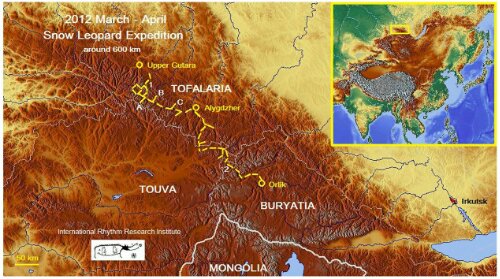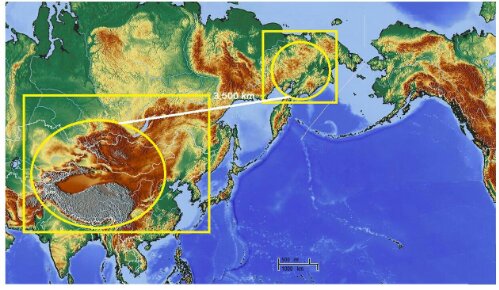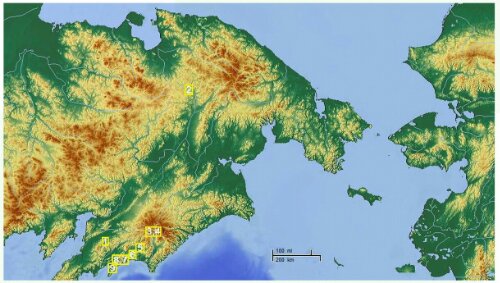Snow Leopard Network member Evgeniy Kashkarov recently distributed an article on his recent findings of snow leopards in two areas, based on unusual migration patterns. The first area is Tofalaria – the northern abrupt edge of Central Sayan Mountains on 540 N latitude (intersection of Western and Eastern Sayan Mountains), and the second one is Chukotka – abrupt edge of Asia, bordering Alaska on latitude of the Arctic Circle.
Text of the article is as follows:
Dear Snow Leopard Friends,
I would like to introduce you two news, related to snow leopard discoveries in most marginal areas, we could ever imagine. First area is Tofalaria – the northern abrupt edge of Central Sayan Mountains on 540 N latitude (intersection of Western and Eastern Sayan Mountains), and the second one is Chukotka – abrupt edge of Asia, bordering Alaska on latitude of the Polar Circle (maps 1-3).

Map 1. Tofalaria-Touva-Buryatia snow leopard expedition, March-April 2012.
Legend: dotted line – expedition route; A (Chelo-Mongo River), B (Upper Honda River), C (Lower Honda River) – areas, where the snow leopards were killed by musk deer snares in February 2012 (two individuals), and one individual approximately five years ago; 1 (Big Murkhoi River, Tofalaria) and 2 (Zhombolok River, Buryatia) – areas, where the snow leopard footprints were observed at expedition time. Note: all mountains on represented map of Buryatia have stable core of the snow leopard population. It was confirmed by results of our field research in 1991, 1993, 1995, 1997, 2010, and 2012. Into bordering territory of Mongolia (Western Hovsgool Mountains) the snow leopard migrates from Buryatia, but in summer only. General distance of migrations is equal to sixty kilometers from Buryatia border (this is data from our survey in 1995, 1997).

Map 2. Location of the snow leopard discovery in Chukotka-Kamchatka area.
Legend: circled areas show the cores, and squared – periphery of the snow leopard observations
DISCOVERIES OF THE SNOW LEOPARD IN MOST MARGINAL AREAS IN THE NORTH
Tofalaria
It is sable, reindeer and snow leopard country. But until February 2012 no one scientist could prove the snow leopard existence here. Tofalaria was known for most northern population of Ibex, but not for the snow leopard. In February 2012 two snow leopards were killed by musk deer snares and sold by hunters to merchant from Nizhne-Udinsk – the nearest big city in 280 kilometers from Tofalaria capital – Upper Gutara village (see map 1). Then snow leopard skins were tried to sale via Internet and attracted attention of Irkutsk region (Tofalaria included in this area) and Buryatia administrations, police, hunting inspection, and court. I met this news in Nizhne-Udinsk in March, when already came there for expedition. For years after my discovery of the snow leopard in 1990s in Eastern Sayan and Western Hovsgool Mountains (see bibliography), populated by Ibex, I was sure, the snow leopard must inhabit the similar territories in Tofalaria. It was simply most remote and hardly accessible area, and for this reason no one zoologists has been look for the snow leopard. In March-April 2012 we covered with my partner Pavel Alexandrov around 600 kilometers between Upper Gutara, Alygdzher and Orlik villages in Tofalaria-Touva-Buryatia (map 1). I would like to take whole picture of this territory, collect field data and answer the question: has Tofalaria resident population of the snow leopard or that species migrates to Tofalaria from Touva-Buryaia? The nearest to Tofalaria snow leopard core, known to me, was the basin of Zhombolok River in Buryatia (its location is near figure 2 on the map 1). In 1995 we discovered there the good size snow leopard population also with Pavel Alexandrov (see bibliography). Complete information about results of our expedition will be published in next issue of the Rhythm Journal http://www.rhythmjournal.com.

Map 3. Data of Rodion Sivilobov of snow leopard presence in Chukotka-Kamchatka range.
Legend: 1-poached, 1979; 2 – visual observation, 1987; 3 – found dead, 1974; 4 – footprints in summer, 2009; 5 – visual observation, 1962; 6 – poached, 1991; 8 – footprints in winter, 1982 and 2010; 9 – visual observation, 1982.
Chukotka
News about discovery of the snow leopard in Chukotka (map 2, 3) I got in February 2012 from crypto zoologist Rodion Sivolobov. For long time he looked there for the cave bear, survived from Pleistocene, and occasionally collected all information, linked to unusual big cat known between hunters, fishers, and geologists… From 1960s big cats and their footprints were observed in area from Northern Kamchatka to Chukotka (map 3). Because Rodion was not sure at first what kind cat inhabits his study area, he called it the Beringian Snow Cat. Some people have seen the cat, describe it as the snow leopard. Foot prints, collected by Rodion, say: it could be snow leopard and Amur tiger both. At least such conclusion is possible to make from photos. Complete information about discovery of big cats in north-eastern edge of Asia will be published in next issue of the Rhythm Journal http://www.rhythmjournal.com I have to add, that we learned a lot of novelty at the time of Global Warming in 1990s-2000s. Tofalaria and Chukotka discoveries of the snow leopard represent extraordinary cases unknown earlier. If snow leopards survived in both areas from Pleistocene and are residential, it is not less interesting than in cases of their migrations. The current migration way of the snow leopard just shows an ancient way use to by snow leopard historically. It is especially interesting for Chukotka, located in Beringian Pleistocene bridge, connected Asia and America in the Ice Age. In 2008 we already described the phenomenon of periodical long distance migrations, rarely observed in populations of snow leopard, Amur leopard and Amur tiger, and caused by the hundred-year rhythm of climate’s warming (see bibliography). In last three centuries migrations of big cats in 1,000 kilometers from the main core of the range were well documented for Yakutia and Transbaikal territories, but never for Tofalaria and Chukotka.
Is someone will be interested in to support our field research in Tofalaria and Chukotka, please contact us by email rjournal.letters@gmail.com Evgeniy Kashkarov, PhD International Rhythm Research Institute.
Bibliography
Koshkarev E.P., 1994. Evaluation of the Presence of the Snow Leopard and the Ibex in South Siberia // Proceeding of the Seventh Int. Snow Leopard Symposium (July 25-30, 1992, China), 17-27.
Кошкарёв Е., 1995 а. Есть ли снежный барс на Байкале? Информационно-методический бюллетень «Волна», Иркутск.
Koshkarev E.P., 1995b. Has the Snow Leopard Disappeared from Eastern Sayan and Western Hovsogol? // report on 8th International Snow Leopard Symposium Proceedings (Islamabad, Pakistan, November 12-16, 1995), published in 1997, 96-107.
Koshkarev E.P., 1996. The Snow Leopard in its North-eastern Range // Cat News, Bulletin of IUCN, Switzerland, no. 25.
Koshkarev E.P., 1997a. Snow Leopard (Uncia uncia) in Western Hovsgol, Mongolia // Report for Discovery Initiatives, London, UK.
Koshkarev E.P., 1997b. Survey of the Snow Leopard in Northern Marginal Range of Southern Siberia // Report for Wildlife Conservation Society, NY, USA. Koshkarev E., 1998. The Snow Leopard along the border of Russia and Mongolia // IUCN Cat News , bulletin of the International Union for Conservation of Nature and Natural Resources, Switzerland, no. 28, pp.12-14.
Kashkarov Evgeniy, Peter Baranov, Oleg Pomortsev, and Igor Ishchenko, 2008. Global Warming and the Northern Expansion of the Big Cats of Asia // Cat News 48, Spring, 24-27.
Баранов П.В., Кашкаров Е.П., 2008. Зоогеографический феномен: вековой ритм расселения крупных кошек на северной периферии ареала // Rhythm Journal – журнал РИТМ, N2, Сиэтл-Иркутск, 232-247.
Kashkarov E., P.Baranov, O.Pomortsev, and I.Ishchenko. Hundred-year Cycle and the Northern Expansion of the Big Cats of Asia // Rhythm Journal – журнал РИТМ, N2, Seattle – Irkutsk, 2008, 248-254.
Кашкаров Е.П., Баранов П.В., Поморцев О.А., 2009. Вековые пульсации ареалов млекопитающих // Rhythm Journal-журнал Рiтм, N2, 44-50.
Кашкаров Е.П., 2010. Cтратегия сохранения снежного барса // журнал Рiтм, 2010 (6), 187-195. Kashkarov Evgeniy, 2010. Snow Leopard Survival Strategy // Rhythm Journal, 2010 (6), 196-204.
Баранов П.В., Кашкаров Е.П., 2011. Большие кошки идут на север // Экология и жизнь N1 (110) 61-63.
